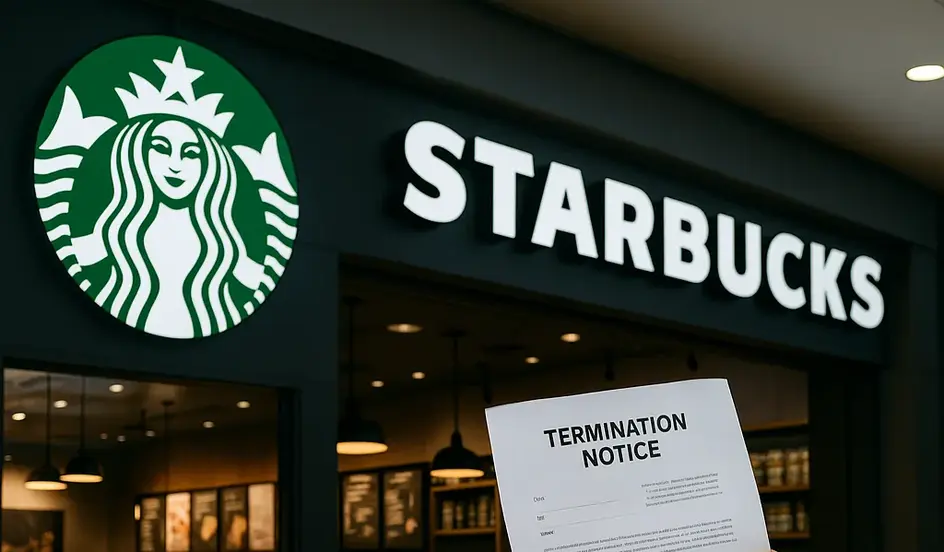Starbucks restructuring plan represents a dramatic shift in strategy as the coffee giant announces it will close 1% of its stores and eliminate 900 jobs in a comprehensive effort to right-size its operations and improve profitability. This marks the second round of job cuts since CEO Brian Nichols took over just over a year ago, signaling the company’s continued struggle to adapt to changing market conditions and operational challenges.
The restructuring comes at a critical juncture for Starbucks, with shares down 6% since Nichols assumed leadership and investors increasingly demanding concrete action to address the company’s operational inefficiencies. The $1 billion restructuring cost reflects the magnitude of the changes needed to transform Starbucks into a more streamlined, profitable operation.
The decision to close stores and cut jobs represents the “hard part” of corporate transformation – moving beyond splashy announcements about menu simplification and customer experience improvements to make difficult operational decisions that directly impact employees and communities. While previous initiatives like allowing customers to refill their own milk and reducing menu complexity have shown promise, they haven’t been sufficient to address the underlying structural issues facing the company.
The restructuring plan reflects a broader industry trend as food service companies grapple with rising costs, changing consumer preferences, and increased competition. Starbucks’ approach of closing underperforming stores while reinvesting in refurbishing existing locations and building new ones represents a strategic pivot toward quality over quantity in its store portfolio.
The Strategic Rationale Behind Store Closures
The decision to close 1% of Starbucks stores reflects a strategic shift from aggressive expansion to focused optimization. The company has identified underperforming locations that have struggled for extended periods, recognizing that maintaining these stores drains resources that could be better invested in more promising locations and operational improvements.
This approach represents a departure from Starbucks’ historical growth strategy, which emphasized rapid expansion and market penetration. The company is now prioritizing store quality and profitability over sheer numbers, recognizing that not all locations can be successful in the current market environment.
The store closures are part of a broader effort to “right-size” the company’s operations, eliminating locations that don’t contribute meaningfully to overall profitability while maintaining a strong presence in key markets. This selective approach allows Starbucks to focus its resources on locations with the greatest potential for success.
The decision also reflects changing consumer behavior and market dynamics. With increased competition from both traditional coffee shops and new entrants, Starbucks needs to ensure that each location provides a compelling value proposition and strong financial performance.
The Strategic Rationale Behind Store Closures
Starbucks’ shift from expansion to optimization shows how businesses adapt to evolving markets and consumer behavior. Employers can do the same by building resilient teams focused on quality, innovation, and long-term growth. Post your job on WhatJobs today and connect with professionals ready to help your business thrive in a changing landscape.
Post a Job Free for 30 Days →The Human Cost: 900 Jobs Lost
The elimination of 900 jobs represents a significant human cost of the restructuring process. These job cuts affect real people and families, highlighting the difficult trade-offs involved in corporate transformation. The decision reflects the company’s assessment that reducing its workforce is necessary to achieve operational efficiency and financial stability.
The job cuts are likely concentrated in areas where stores are being closed, as well as in corporate and support functions that are being streamlined. This approach minimizes disruption to ongoing operations while achieving the necessary cost reductions.
The timing of these job cuts, coming just over a year after Nichols took over, suggests that the initial assessment period has concluded and the company is now implementing the difficult decisions needed to turn around its performance. This represents a shift from the “splashy announcements” phase to the hard work of operational restructuring.
The impact on employees extends beyond those directly affected by job cuts. The restructuring creates uncertainty for remaining employees about their job security and the company’s future direction. Managing this uncertainty while maintaining morale and productivity will be a key challenge for Starbucks leadership.
The $1 Billion Restructuring Investment
The $1 billion restructuring cost represents a significant investment in the company’s future, reflecting the magnitude of the changes needed to transform Starbucks’ operations. This investment covers the costs of closing stores, severance payments for affected employees, and the refurbishment of approximately 1,000 existing locations.
The refurbishment program represents a key component of the restructuring strategy, focusing on improving the customer experience and operational efficiency of existing stores rather than simply expanding the store count. This approach recognizes that quality improvements can be more effective than quantity expansion in driving profitability.
The investment also reflects the company’s commitment to building for the future, with plans to resume new store construction next year. This suggests that the current restructuring is designed to create a stronger foundation for future growth rather than simply reducing the company’s footprint.
The size of the investment demonstrates the company’s recognition that significant changes are needed to address its operational challenges. This level of investment suggests confidence that the restructuring will generate meaningful returns in terms of improved profitability and operational efficiency.
The $1 Billion Restructuring Investment
Starbucks’ $1B investment in restructuring and refurbishing highlights how bold strategies can drive future growth. Employers can follow this lead by investing in people and operations that strengthen long-term success. Post your job on WhatJobs today and connect with talent ready to help build the foundation for tomorrow’s growth.
Post a Job Free for 30 Days →The Challenge of Operational Transformation
The restructuring represents a shift from the “aesthetics at the front” approach to addressing fundamental operational issues. While previous initiatives like menu simplification and customer experience improvements have shown promise, they haven’t been sufficient to address the underlying structural problems facing the company.
The challenge now is to implement the difficult operational changes needed to improve profitability while maintaining customer satisfaction and employee morale. This requires careful execution of store closures, job cuts, and operational improvements without disrupting the customer experience.
The restructuring also requires managing the negative publicity that often accompanies store closures and job cuts. This can impact customer perception and brand reputation, making it important to communicate the strategic rationale behind these decisions clearly and effectively.
The success of the restructuring will depend on the company’s ability to execute these changes efficiently while maintaining its core value proposition to customers. This requires careful planning and execution to minimize disruption while achieving the desired operational improvements.
The Market Response and Investor Expectations
The market’s relatively flat response to the restructuring announcement suggests that investors were expecting these changes and view them as necessary steps toward improving the company’s performance. This reflects a recognition that Starbucks needs to make difficult decisions to address its operational challenges.
Investors are looking for evidence that the restructuring will generate meaningful improvements in profitability and operational efficiency. The success of the refurbishment program and the resumption of new store construction will be key indicators of whether the restructuring is achieving its intended goals.
The market response also reflects the understanding that corporate transformation takes time and that the benefits of restructuring may not be immediately apparent. Investors are likely to be patient as the company implements these changes, but they will expect to see progress over the coming quarters.
The relatively muted market response suggests that investors view the restructuring as a necessary step rather than a positive development. This reflects the reality that while these changes may be necessary, they represent a cost rather than a benefit in the short term.
Frequently Asked Questions
Starbucks restructuring plan – what does it involve?
Starbucks restructuring plan includes closing 1% of stores, cutting 900 jobs, and investing $1 billion in restructuring costs while refurbishing 1,000 existing stores and planning to resume new store construction next year.
Why is Starbucks closing stores and cutting jobs?
Starbucks is closing underperforming stores and cutting jobs to right-size its operations, improve profitability, and focus resources on locations with the greatest potential for success rather than maintaining unprofitable locations.
How much will the Starbucks restructuring cost?
The Starbucks restructuring will cost $1 billion, covering store closures, severance payments for affected employees, and the refurbishment of approximately 1,000 existing locations to improve customer experience and operational efficiency.
What does this mean for Starbucks employees?
The restructuring means 900 employees will lose their jobs, while remaining employees face uncertainty about job security and the company’s future direction, requiring careful management to maintain morale and productivity.
How are investors responding to the Starbucks restructuring?
Investors responded relatively flat to the restructuring announcement, viewing it as a necessary step rather than a positive development, with expectations that the changes will improve profitability and operational efficiency over time.
What’s the future outlook for Starbucks after restructuring?
The future outlook depends on successful execution of store closures, refurbishment programs, and resumption of new store construction, with the goal of creating a more sustainable and profitable growth model.
A Real-World Example: The Store Manager’s Perspective
Maria Rodriguez, a Starbucks store manager in a suburban location that was recently closed as part of the restructuring, shares her experience of the difficult transition. “When we got the news that our store was closing, it was devastating for our entire team,” she explains. “We had built a real community here, and suddenly we were all facing unemployment.”
Maria’s store had been struggling with declining sales for over two years, despite efforts to improve customer service and implement new menu items. “We tried everything – better training, new equipment, different marketing approaches,” she says. “But the foot traffic just wasn’t there, and our costs kept rising.”
The closure process was handled with sensitivity, according to Maria. “Starbucks provided good severance packages and helped us with job placement services,” she explains. “They also gave us the option to transfer to other stores, though many of us chose to take the severance and look for other opportunities.”
Maria’s experience highlights the human impact of corporate restructuring. “It’s not just about numbers on a spreadsheet,” she says. “These are real people with families, mortgages, and dreams. When a store closes, it affects the entire community – customers, employees, and local businesses that depend on our foot traffic.”
The closure also provided Maria with insights into the challenges facing the company. “I could see why they had to make these decisions,” she explains. “Our store was losing money every month, and that’s not sustainable. Sometimes you have to make hard choices to save the company.”
Maria’s advice to other Starbucks employees reflects the lessons she’s learned. “Don’t take it personally if your store closes,” she says. “It’s a business decision, not a reflection of your work. Use the experience to grow and find new opportunities.”
Maria’s story demonstrates that while restructuring is necessary for corporate survival, it has real human costs that must be managed with care and compassion. The success of the restructuring will depend not just on financial metrics but on how well the company treats the people affected by these changes.
Don’t Let Corporate Restructuring Derail Your Career
The Starbucks restructuring represents a significant shift in corporate strategy, but it also highlights the importance of adaptability and resilience in today’s rapidly changing business environment. For employees and job seekers, this situation offers valuable lessons about navigating corporate transformation and building career resilience.
The key to success in this environment is to focus on developing skills and experiences that are valuable across different companies and industries. This means investing in continuous learning, building a strong professional network, and developing expertise that can be applied in various contexts.
For those affected by job cuts, it’s important to remember that corporate restructuring is often a reflection of business strategy rather than individual performance. The skills and experience gained at companies like Starbucks are valuable and transferable to other organizations.
The restructuring also highlights the importance of staying informed about industry trends and company performance. Understanding the broader context of corporate decisions can help individuals make better career choices and position themselves for success in changing markets.
The future of work will likely involve more frequent corporate restructuring as companies adapt to changing market conditions. Those who can navigate these changes successfully will be better positioned for long-term career success.




